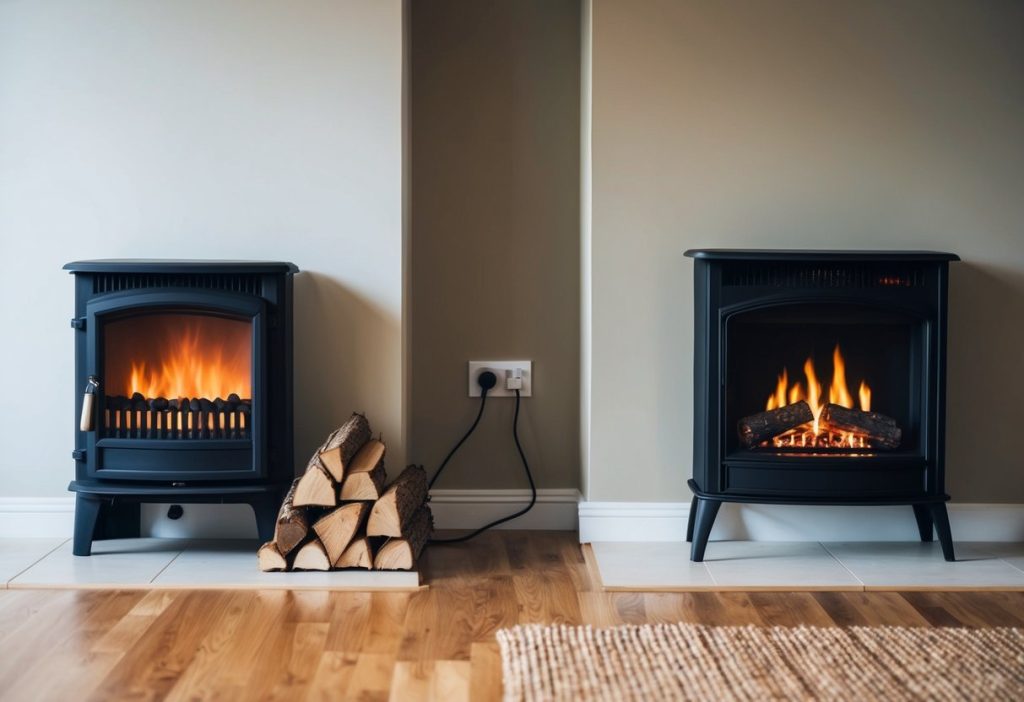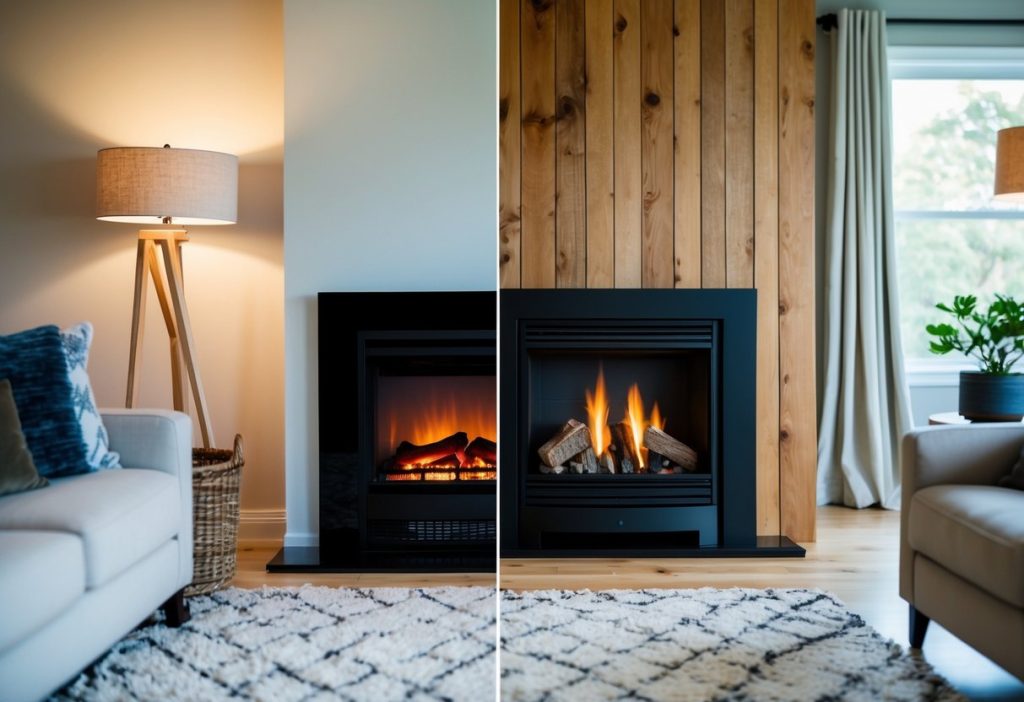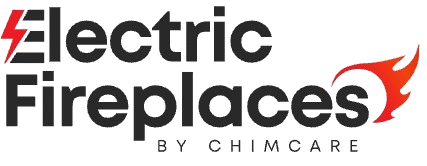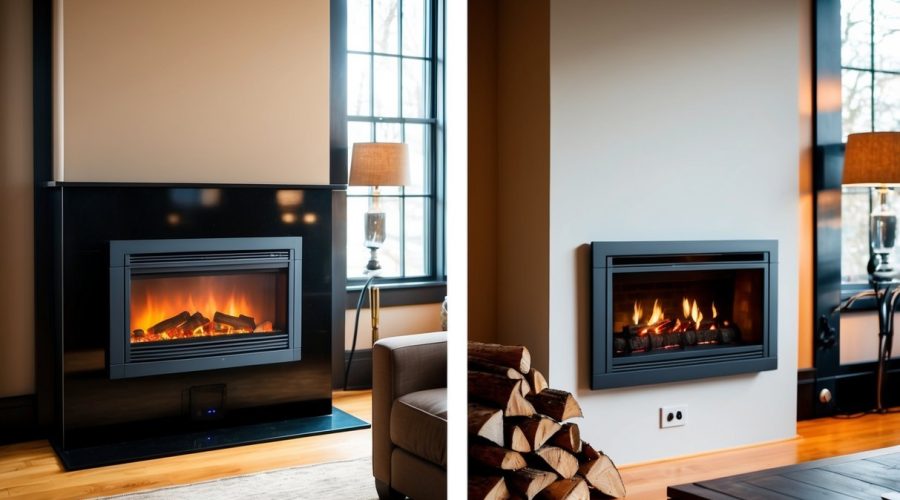Electric vs. Wood Fireplaces: Cost-Saving Analysis
Choosing between an electric and a wood fireplace can significantly impact our savings. While wood fireplaces carry an authentic charm, they also come with the cost of purchasing wood and potential installation expenses that can escalate quickly. In contrast, electric fireplaces offer efficiency by minimizing heat loss and often lead to reduced energy bills due to their ability to allow zonal heating. When weighing costs, electric fireplaces generally prove more economical over time.
With electric fireplaces, installation is straightforward, often less expensive, and avoids the maintenance tasks that come with wood-burning systems. On the other hand, wood fireplaces provide a more traditional experience, carrying both ambiance and the occasional requirement for chimney cleaning. As we consider what’s best for our needs, it’s essential to keep in mind our budget, desired aesthetic, and environmental impact, each of which plays a significant role in our decision.
Key Takeaways
- Electric fireplaces tend to be more budget-friendly in the long run.
- Installation and operational costs are typically lower for electric models.
- Wood fireplaces offer a unique charm but might incur higher maintenance costs.
Understanding Different Fireplace Types

In our examination of fireplace options, it is crucial to consider cost, efficiency, and ambiance. Each type of fireplace—electric, wood, and gas—offers unique benefits and drawbacks.
Electric Fireplaces: Pros and Cons
Electric fireplaces are convenient and versatile. They are the most affordable types to purchase and install, making them a budget-friendly choice. With straightforward installation, they are ideal for renters or those seeking a non-permanent solution. Electric fireplaces generate heat efficiently and allow for temperature control without needing ventilation.
They also emit no pollutants or carbon monoxide, ensuring a healthy indoor environment. However, electric fireplaces lack the traditional ambiance of crackling wood and glowing embers. They depend on electricity, which may not be suitable for emergency heating during power outages. The flame effect, while realistic, may not satisfy those seeking an authentic experience.
Wood Fireplaces: Pros and Cons
Wood-burning fireplaces offer a classic appeal with the sights, sounds, and smells of a real fire. They are known for creating a cozy and inviting atmosphere. On the economic side, wood can often be sourced for free, reducing operating costs. However, they require significant labor for installation and ongoing maintenance like chimney cleaning and ash disposal.
They also need proper ventilation to manage emissions and prevent buildup of harmful substances like carbon monoxide. In terms of efficiency, older models may convert only a small portion of wood into heat, but modern designs have improved significantly. The authentic experience may come with a trade-off in terms of environmental impact and energy efficiency.
Gas Fireplaces: An Overview
Gas fireplaces provide an attractive balance between convenience and authenticity. They are easier to operate compared to wood fireplaces and deliver consistent heat at the touch of a button. Most models come with adjustable flames for customizable ambiance. Gas fireplaces tend to have higher efficiency rates and fewer emissions than traditional wood fireplaces.
Despite these advantages, installation can be complex and may require professional help, especially for vented models. Proper ventilation is essential to ensure safe operation. While more efficient than wood fireplaces, they may not have the same charm but still offer a warm, realistic flame effect suitable for many homes.
Installation and Maintenance Costs

When comparing electric and wood fireplaces, we need to consider both the initial installation and ongoing maintenance costs. These expenses can vary significantly based on the type of fireplace chosen.
Setup: Initial Costs of Fireplaces
The initial installation cost of fireplaces can differ greatly. Electric fireplaces are often more affordable and easier to install since they do not require a chimney or venting. This makes them a popular choice for those looking to avoid extensive home renovations. Typically, electric fireplace inserts can be added without major structural changes, keeping costs low.
In contrast, wood fireplaces, especially traditional ones, can be expensive to install due to the need for a chimney and possible structural modifications. The cost of a wood stove can range from $5,000 to $10,000, including the necessary venting and chimney. Natural gas fireplaces also require professional installation but tend to be less invasive than wood-burning setups.
Long-Term: Sustaining Your Fireplace
Maintenance costs also play a crucial role in determining the long-term affordability of fireplaces. Electric fireplaces require minimal upkeep, with no need for regular cleaning or chimney maintenance. This ease of maintenance can translate to substantial savings over time, as there are no costs associated with creosote build-up or chimney sweeps.
Meanwhile, wood fireplaces demand more regular attention. They require chimney cleaning to prevent creosote build-up, which poses a fire hazard. Maintaining a consistent wood supply adds to the costs, and proper stove upkeep is necessary to ensure safety and efficiency. Regular inspections and repairs can increase the ongoing expenses associated with wood-burning fireplaces.
Energy Efficiency and Operating Costs

When considering energy efficiency and operating costs, electric and wood fireplaces each have their advantages. Choosing the right type can significantly impact energy bills and overall energy consumption. Let’s explore how each option measures up.
Electric vs. Wood: Energy Consumption
Electric fireplaces offer a more energy-efficient solution, converting nearly 100% of electricity into heat. They work well for zone heating, allowing us to focus warmth in specific areas rather than heating the whole house.
Wood fireplaces, on the other hand, can be less efficient. Much of the heat escapes through the chimney, reducing heat output within the home. Although wood can sometimes be sourced for free, the energy loss impacts overall efficiency.
Saving on Energy Bills with the Right Choice
When considering how different fireplaces affect energy bills, electric fireplaces typically cost less to operate than traditional wood fireplaces. Their efficiency in converting electricity into heat minimizes waste and allows for strategic heating during peak cost times.
Using electric fireplaces in conjunction with LED light bulbs and HVAC systems can further enhance energy savings. For those looking to optimize energy and cost savings, electric fireplaces paired with efficient space heaters can form an effective solution for warmth and lower bills.
Safety and Environmental Considerations

When it comes to fireplaces, both safety and environmental concerns are critical. Electric fireplaces generally offer superior safety features, while wood-burning fireplaces present specific environmental challenges. Let’s examine these factors more closely.
Comparing Safety Features
Electric fireplaces are known for their safety due to the absence of real flames. This design reduces the risk of accidental fires and eliminates carbon monoxide emissions entirely. Since there are no open flames or combustible materials, they are suitable for households with pets or small children.
In contrast, wood-burning fireplaces involve open flames, which pose a higher risk of fire hazards. The incomplete combustion of wood can lead to carbon monoxide production. It’s crucial to install carbon monoxide detectors and keep a fire extinguisher nearby for added safety.
Eco-Friendly Fireplace Solutions
Modern electric fireplaces excel in energy efficiency, converting all their energy use into heat with no emissions. This makes them a more environmentally friendly choice compared to wood-burning options. They don’t contribute to air pollution and have minimal impact on our environment.
Wood-burning fireplaces, while traditional and cozy, can have a negative environmental impact. The burning process releases fine particulates and carbon dioxide, contributing to air pollution. To mitigate this, we can consider EPA-certified stoves which reduce fine particle emissions significantly, offering a greener alternative while retaining the charm of a wood fire.
Aesthetics and Experience

Both electric and wood fireplaces offer unique aesthetic qualities that can significantly enhance the atmosphere of any room. Choosing between them often comes down to personal preference regarding flame authenticity and the type of ambiance you wish to create.
Visual Appeal: Flame Patterns and Design
One of the most striking differences lies in how electric and wood fireplaces present flame patterns. Wood fireplaces provide authentic flame and burning logs, creating a traditional look that appeals to those who appreciate natural elements and the crackling sound of burning wood. This can create a rustic and cozy feel that is hard to replicate.
Electric fireplaces, on the other hand, excel in versatility and convenience. Many modern models now offer highly realistic flame patterns that mimic the flickering and color variation of a real wood fire. These digital flame displays are often adjustable, allowing users to control settings for brightness, color, and even flame speed. This flexibility can be particularly appealing if we desire a specific look or want to change the vibe according to different occasions.
Creating an Ambiance with Your Fireplace
The ambiance a fireplace creates goes beyond just visual appeal. Wood fireplaces exude a sense of tradition and nostalgia, often associated with warmth and family gathering around for leisure or during holidays. The characteristic smell and sound of wood burning contribute to this, adding another layer of sensory experience.
In contrast, electric fireplaces shine as user-friendly devices, often equipped with features such as backlighting and integrated heaters to control the ambiance. These fireplaces can be turned on or off with ease, allowing us to enjoy the glow without heat when desired. This makes them an excellent choice for settings where a flexible atmosphere is crucial, like in modern homes or entertainment areas.
Frequently Asked Questions
When comparing electric and wood fireplaces, there’s often a focus on the expenses and economic benefits of their operation and maintenance.
What are the cost comparisons between operating a wood fireplace and an electric fireplace?
Operating a wood fireplace often involves costs like purchasing wood and maintenance. In contrast, electric fireplaces typically incur costs related to electricity usage. While wood may seem cost-effective in terms of fuel, electric fireplaces are more straightforward with fewer maintenance tasks and uniform costs.
How much energy does an electric fireplace use and what can I expect in monthly expenses?
Electric fireplaces usually consume between 1.5 to 2 kilowatts per hour. The cost depends on local electricity rates. On average, using an electric fireplace might add about $50 to $100 to monthly utility bills. Factors such as usage duration and frequency can impact these expenses.
Are wood burning stoves more economical than electric fireplaces for heating a home?
Wood burning stoves can often be more economical than electric fireplaces, especially if the wood is sourced cheaply or for free. Initial costs for wood stoves and associated maintenance might be higher, yet they can offer substantial savings in the long run depending on local wood prices and availability.
What are the disadvantages associated with using an electric fireplace for home heating?
Electric fireplaces often have higher operational costs due to electricity consumption. They provide less heat output than wood-burning options and rely on electricity, making them less ideal during power outages. Aesthetically, some users find them less authentic than traditional wood fireplaces.
Can installing an electric fireplace insert lead to significant savings on heating costs?
Electric fireplace inserts can lead to savings by providing zone heating, reducing reliance on central systems. They are effective for supplementing heat in specific areas, which may lower overall home heating expenditures. However, standalone usage might not substantially reduce costs where electricity rates are high.
Which type of fireplace offers the best long-term cost savings for homeowners?
Long-term savings depend on various factors, such as fuel availability, local energy rates, and personal usage patterns. Wood fireplaces might offer better savings where wood is affordable and abundant. Conversely, electric fireplaces can be more cost-effective in urban environments with limited access to wood resources.

